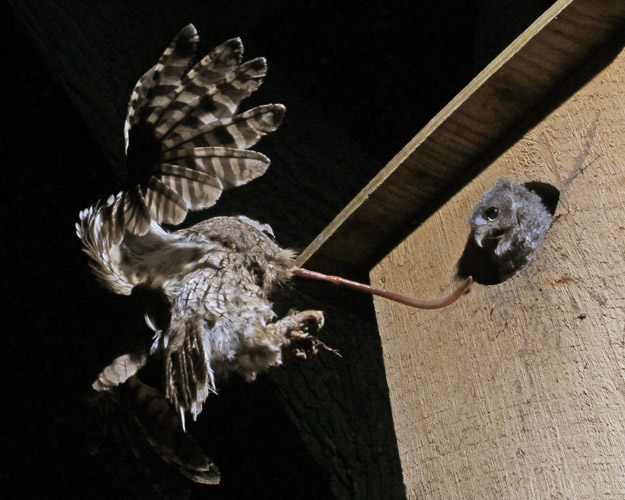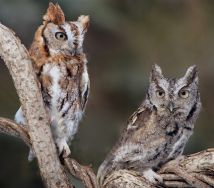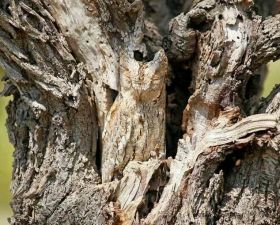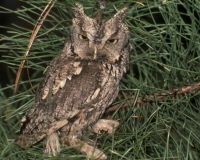We recognized the haunting trill as an Eastern Screech Owl and quietly celebrated our find as the song grew closer. Within a minute, the owl was singing out from the dark some 25-50 feet away. Finally, a colleague let slip his excitement and interrupted Paul to let the group know that the noise in the dark was in fact, an Eastern Screech Owl! Without even pausing to feign interest, Paul continued his presentation with ”thanks Tim. And, screech owls are one of the biggest predators of Red Bats around.” Ha! Okay, so not everyone is as fond of owls as most bird lovers.
 The Eastern Screech Owl (Megascops asio) is native to the United States, found from Montana to Massachusetts and from southern Ontario to northern Mexico. In Wisconsin, Eastern Screech Owls can be found throughout the southern half of the state in mixed woodland habitats (suburban and rural), riparian woods including streams and wetlands and mature meadows and fields. They adapt to many habitats and will even take readily to nest boxes (right). Eastern screeches are fairly common and are estimated to have a population of about 770,000 birds.
The Eastern Screech Owl (Megascops asio) is native to the United States, found from Montana to Massachusetts and from southern Ontario to northern Mexico. In Wisconsin, Eastern Screech Owls can be found throughout the southern half of the state in mixed woodland habitats (suburban and rural), riparian woods including streams and wetlands and mature meadows and fields. They adapt to many habitats and will even take readily to nest boxes (right). Eastern screeches are fairly common and are estimated to have a population of about 770,000 birds.
 The Eastern Screech is a small, short-necked owl about 5-9 inches in height and approximately 6 ounces in mass. It has small ear tufts and a pale feathered beak. The stocky little owl varies in color (left); existing in red, gray and brown color morphs. In this part of the country, gray morphs are the most common color, while red morphs comprise a smaller percentage of the population at about a third. Brown morphs make up the smallest portion of the population, estimated around less than 10%. Although they were once thought to be the same species, the Eastern and Western Screech Owls (Megascops kennicottii) are indeed different. Western Screech Owls are found west of the Rockies and exist in only a gray variety. They also have less streaking on the chest and a paler beak than eastern screeches.
The Eastern Screech is a small, short-necked owl about 5-9 inches in height and approximately 6 ounces in mass. It has small ear tufts and a pale feathered beak. The stocky little owl varies in color (left); existing in red, gray and brown color morphs. In this part of the country, gray morphs are the most common color, while red morphs comprise a smaller percentage of the population at about a third. Brown morphs make up the smallest portion of the population, estimated around less than 10%. Although they were once thought to be the same species, the Eastern and Western Screech Owls (Megascops kennicottii) are indeed different. Western Screech Owls are found west of the Rockies and exist in only a gray variety. They also have less streaking on the chest and a paler beak than eastern screeches.
The diet of the nocturnal screech is made up of an extensive array of small animals. These skilled hunters use a swoop and catch technique to capture everything from invertebrates to small mammals. They have been documented eating earthworms (above), crayfish, woodpeckers, lizards, voles, young rabbits and even their own kind. When food is plentiful, screeches will cache their  food in hollow cavities. Natural predators include larger owl species, mammals such as mink and raccoons, and if agitated enough, birds such as jays and crows.
food in hollow cavities. Natural predators include larger owl species, mammals such as mink and raccoons, and if agitated enough, birds such as jays and crows.
Tree cavities serve as the perfect nest for the cavity dwelling screech owl. They place their nests in hollowed out depressions – never building one from scratch. In April, the single brooding female lays 2-8 white eggs directly onto the debris naturally existing in the cavity. The female incubates the eggs for 28 days (with occasional help from the male), leaving the nest cavity only briefly at dusk and/or dawn. Nestlings are born with eyes closed and downy white feathers. The male typically conducts the hunting during this period while the female tears the food into small bits for the chicks. When parents aren't successful hunting and bring less food to the nest, chicks can become fiercely competitive and will kill broodmates (siblicide) to get a greater amount of the food supply. Nestlings fledge in about a month and hang around the parental territory for about 5-6 weeks. At about a year of age the Eastern Screech Owl becomes sexually mature.
Fun Facts:
 At what age does an owl become wise? The longest living Eastern Screech Owl was documented to be at least 14 and a half years old. Maybe they’re just born wise;)
At what age does an owl become wise? The longest living Eastern Screech Owl was documented to be at least 14 and a half years old. Maybe they’re just born wise;)- The big and mighty female! Like many raptor and owl species, the eastern screech female is typically larger than the male, while the male is smaller and more agile.
- Like a needle in a haystack! Although the Eastern Screech Owl sometimes stands at the opening of its cavity, sunning itself during the day (right), its amazing camouflage often allows it to remain undetected by the human eye.
- Who are you calling funny looking?! The Eastern Screech owl has asymmetrical ear openings to allow it to triangulate prey better and capture food more adeptly.
- How many licks does it take to get to the center of a Tootsie Roll pop? The Eastern screech owl may not sound like the Tootsie Roll owl, but his voice is unique enough to have become a conversational theme for many bird lovers. It is often described as “eerie”, “spooky”, “grave”, “shrill” or even “horse-like”. Listen to its song and decide for yourself.
- Is that a gaggle or a flock? Neither! A group of owls is commonly known as a “wisdom”, a “parliament”, or a “bazaar".
*This article was written using sources found on the websites allaboutbirds.org, owlinstitute.org, and wikipedia.org, the article "Morphs of the Eastern Screech Owl" by Ron Pittaway, the phone app iBird Pro and the Sibley Field Guide to Birds of Eastern North America book.





